Here is the Volume 2 of Hockey from When you watch something, visit us first! Mr. Manabu YAMASHITA, Coach of Japanese men’s national Hockey team “Samurai Japan”, told us about how the Hockey match goes and the basic Stick work this time. This is the complete version of Part 3 & 4 on our YouTube channel.
In Vol.1, we learned the basic knowledge of Hockey.
This time, with the cooperation of Japan Hockey Association, Mr. Manabu YAMASHITA, Coach of Japanese men’s national Hockey team “Samurai Japan”, told us how the Match goes and the basic Stick work.
We would like to thank Japan Hockey Association, especially Head Coach of Samurai Japan, Mr. Akira TAKAHASHI, for their great help in making this video. We would like to express our sincere gratitude.
.png)
Part 4: How the Hockey match goes
Match duration
Hockey matches are played in 4 x 15-minute Quarters (Q). 1st Q is 15 minutes, then a 2-minute break, and 2nd Q for 15 minutes. The break between 2nd Q and 3rd Q is 10 minutes as the Half Time. And 3rd Q for 15 minutes, then another 2-minute break, and 15-minute as 4th Q.
Q: What do you do during the break time, which is only 2 minutes?
Well, since we only have 2 minutes, we talk briefly about how the opponent is coming and what we should do.
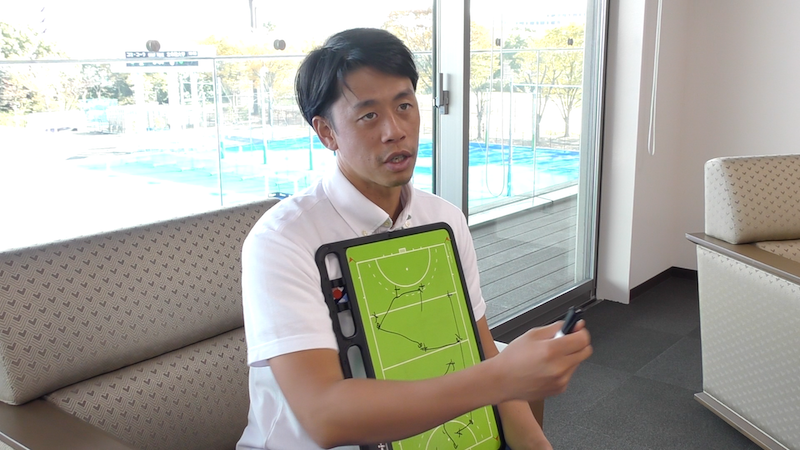
The coaches find points that the players do not notice, and, for example, if the opponent has a weakness on the right side, the coach will give advice such as, “Attack from the right side,” and if the players follow this advice, there will be many chances.
How Hockey Match goes
The match stops when a goal is scored, when a “Penalty Corner” is awarded, when a “Penalty Stroke” is awarded, and also when a card is indicated for a foul. Even if a foul occurs, such as the Ball hitting the body or a player hitting the opponent’s stick, which I explained earlier, play basically continues without time stopping.
The game begins with the way called “Centre Pass,” and the player basically plays the ball backward, but he/she can also play the ball forward. However, players are not allowed to enter the other side.
※Until the ball is played all players other than the player taking the centre pass must be in the half of the field which includes the goal they are defending. (From FIH Rules of Hockey)
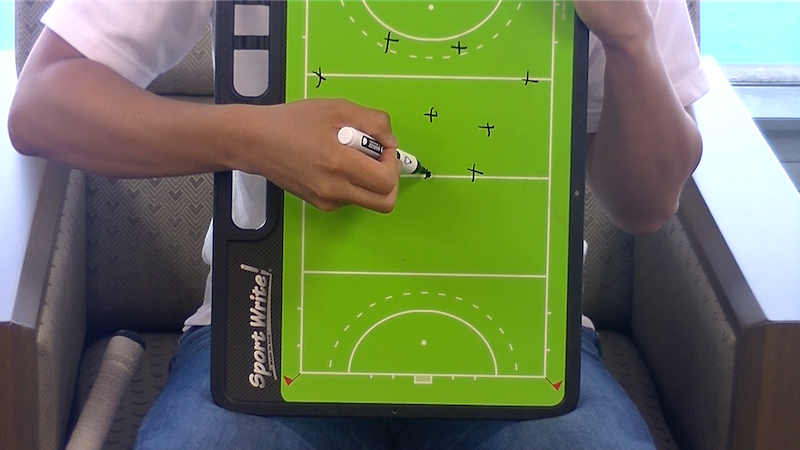
At the backward, 4 Defensive (DF) players generally line up like this, exchanging passes, and Forward (FW) players move forward to stretch the playing area. Meanwhile, Midfield (MF) players also move forward while passing the ball around, or DF players move by overlapping and putting the ball to the Circle, and the players move like this, which is how the match goes basically.
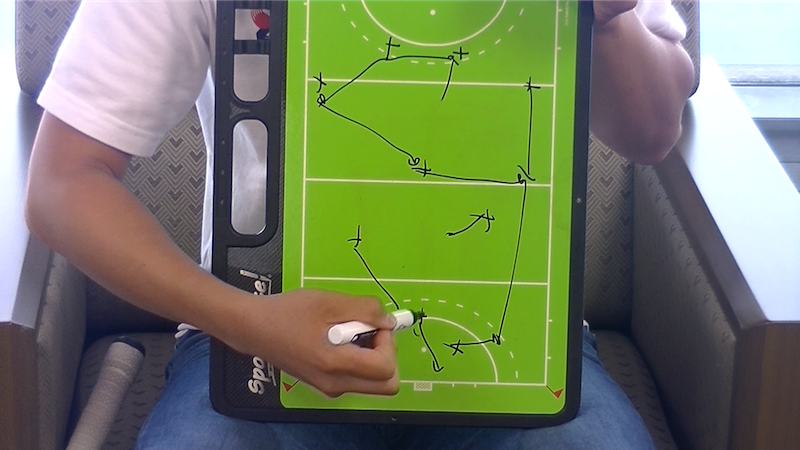
If the ball is lost in such situation, it will be turned over, so every players will go back and defend.
Some teams model their building up on soccer tactics, so I think it would be interesting for those who are familiar with soccer to see Hockey.
Theory of Offense
I think the standard attacking theory is “to attack from the right side.”
During the match, 4 DF players often pass the ball around and then the players on the right side takes a high position. In Hockey, it is often the case that the players on the right side takes a high position to create a numerical advantage on the right side to attack.
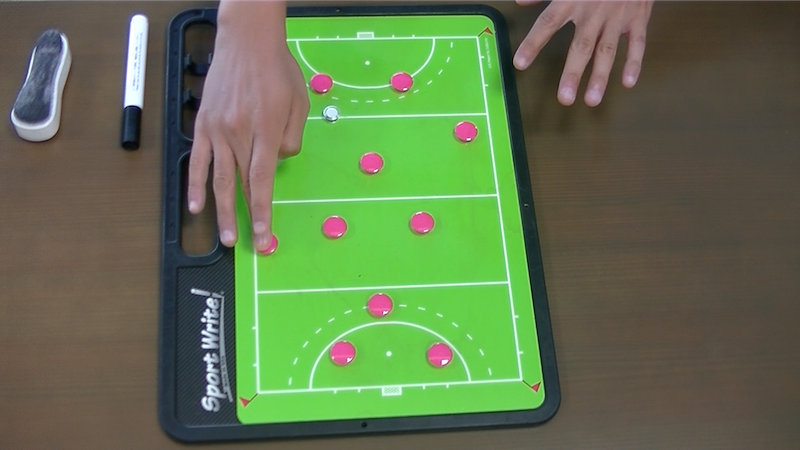
In Hockey matches, attack creating a numerical advantage on the right side, by using MF players to pass the ball around, moving side back (SB), FW players, and even MF players closer to the Circle where they have more chance to score, and eventually sending the ball from SB into the Circle, or from MF players who supports SB player.
In Soccer, there is an Offside rule, so even if there is a space beyond the backmost player, any FW player cannot enter there,
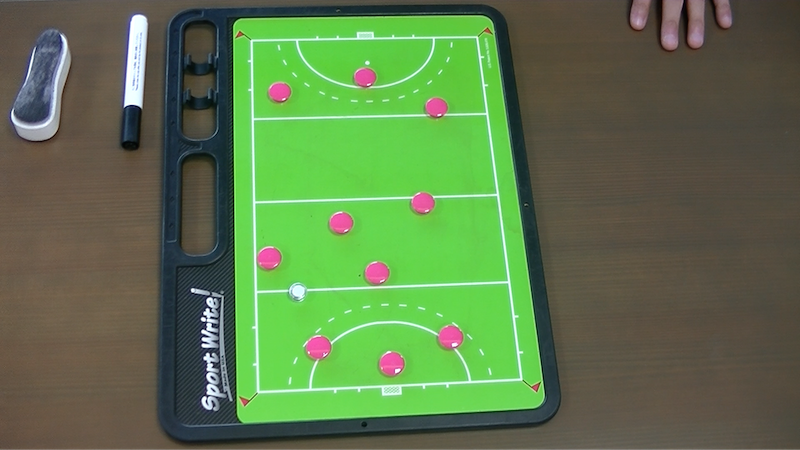
On the other hand, if DF players do not follow FW players, as the ball is fast and it is easy to cross the opponent’s DF line by targeting such FW players.
Part 4: Basic Stick work
Stick work ① Dribble
In Hockey, players hold the Stick like this, but they can only use the Fore side. Of course, it is not enough to go to only the right side all the time; they have to go to the left as well as to the right, so the right hand is basically just holding it, and they basically control the face of the stick by turning their left wrist.
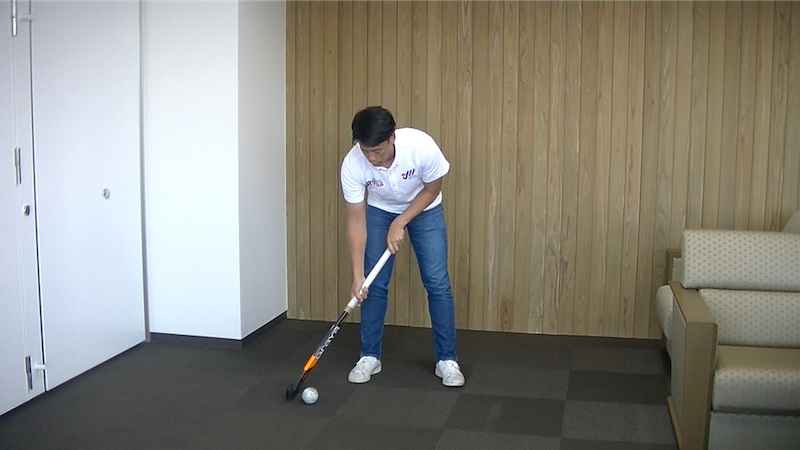
Turning their wrist so the flat side faces this side. Foreside. Left. Right-left. Basically, this is how they dribble.
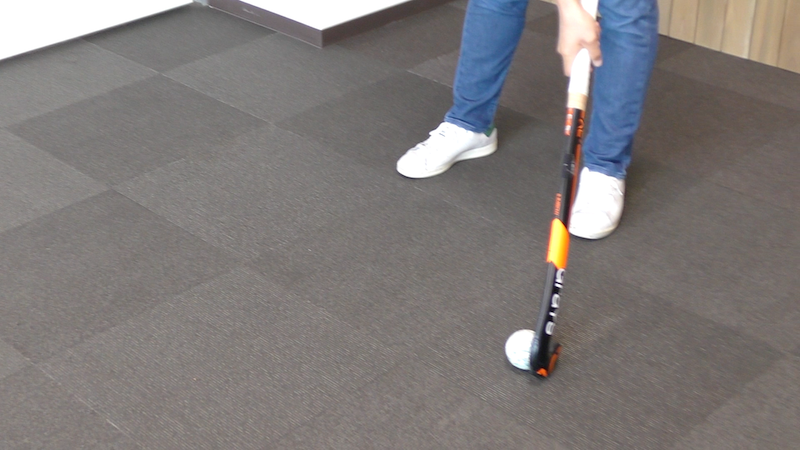
Then, if the opponent’s Stick is placed like this, they float the ball. This technique is to float the ball and evade the opponent’s Stick.
Stick work ② Hit
”Hit” is struck like this, similar to the form of Golf.
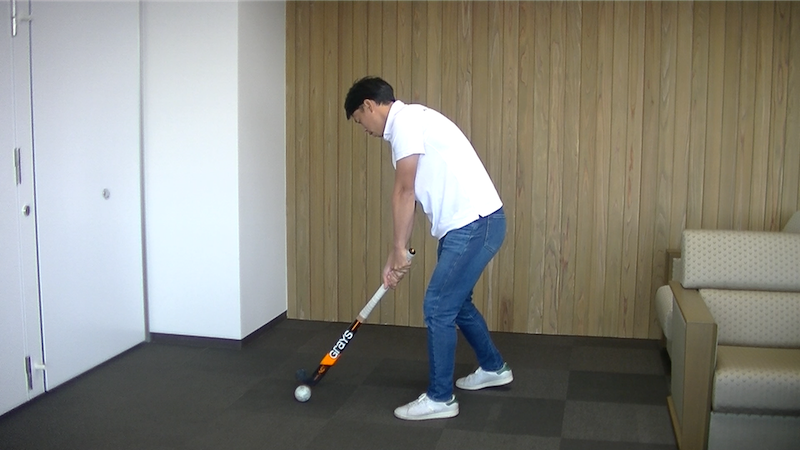
The sweet spot of the Stick, by hitting the ball here, players can hit a very strong ball. This Hit is the strongest stroke in Hockey. It is a foul of “Dangerous Ball” if the ball of Hit rises above the knees. Basically, it is a foul if the ball flies into the place of other players.
The Hit skill is often used when the player want to get a strong ball into the Circle. Or when they want to shoot inside the Circle, this skill is used quite often.
To be honest, Hit is a skill that is prone to misses and is also a weakness, as the ball floats if the players do not hit a good spot on their Stick firmly.
Stick work ③ Sweep
“Sweep” is a method of hitting that keeps the posture quite low and the fingers of the hand just above the pitch surface. This is the Sweep.
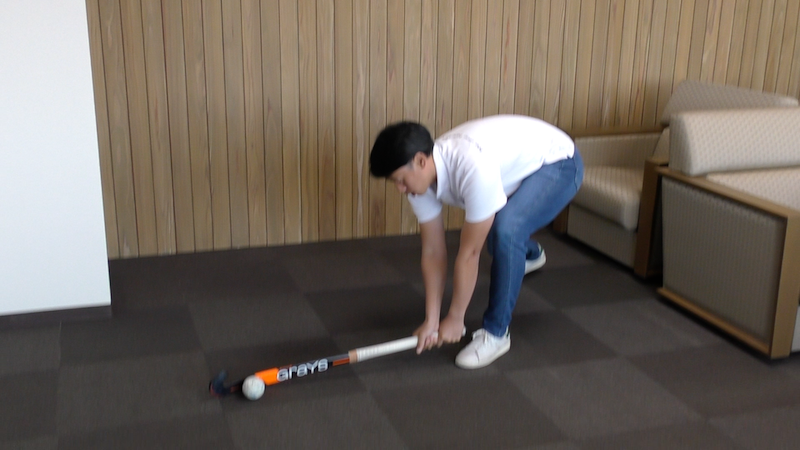
This stroke is used quite often among the DF line.
It is a more consistent than Hit for strong balls, so I think it will be one of the most common strokes seen in a match. FW sometimes use this stroke to intentionally float the ball in shooting situations, but it is basically used by DF players. I also think it is often used by Hockey players because it has a wider surface than the previous Hit, as Sweep can make passes with fewer misses.
It is possible to hit a beautiful ball at the target, but I think Sweep has one weakness: the backswing is quite large, so it is easy to be read by the opponent.
Stick work ④ Push
Push, as the name implies, puts out the left hand and pushes with the right hand. This is Push.
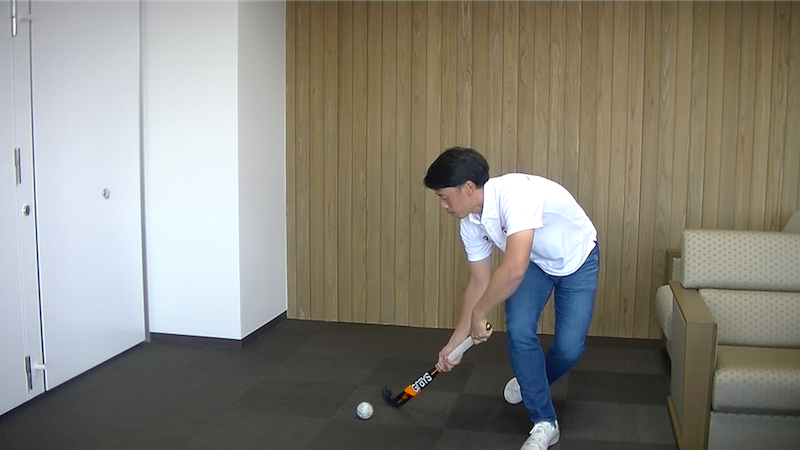
The Push is basically the most common stroke in a Hockey match, as it allows the player to pass while dribbling to any side. It is difficult to send out a strong ball by just pushing though it depends on the player, so it is often used for short passes.
Stick work ⑤ Scoop
The Scoop is a way to easily go over the opponent and connect to a teammate in a way that is not dangerous, and is an extension of the Push where the face of the Stick is pointed slightly upward and the ball is scooped up from below. This is a skill that is used quite a lot these days.

Raising the ball by Scoop is also quite difficult and requires catching and raising the ball firmly on the narrow face of the Stick, which is a very advanced skill.
Stick work ⑥ Drag Flick
There is a stroke called a Drag Flick, which is a Hockey-specific skill used in Penalty Corner shooting. In Penalty Corners, a Hit and this Drag Flick are often used, but a Hit is dangerous because it is swung and hit as hard as possible, and the ball must be at the height of the board of Hockey goal to be allowed to score a goal. But the Drag Flick is not “hitting” the ball, it is just “pushing” the ball, so as long as the ball does not hit the opponent, it will score wherever it enters the goal.
The Push can be pushed out like this at the point, but the Drag Flick “drags” the ball, then slides down the surface of the stick, and finally releases the ball as fast as possible. There are shooters who use this skill to shoot 100 to 120 km/h and score a goal, and I believe that teams with such players who have this high level and special skill are strong.

Stick work ⑦ Reverse Hit
There is a skill called Reverse Hit. We call this side of Stick “Fore side” and the other side “Reverse side,” and the Reverse Hit is a technique of hitting with the point called “Edge” of the Hockey Stick, which is a very high leveled skill and is used by FW players mainly when they shoot.

I think this is a very difficult skill to use.
Share this content:
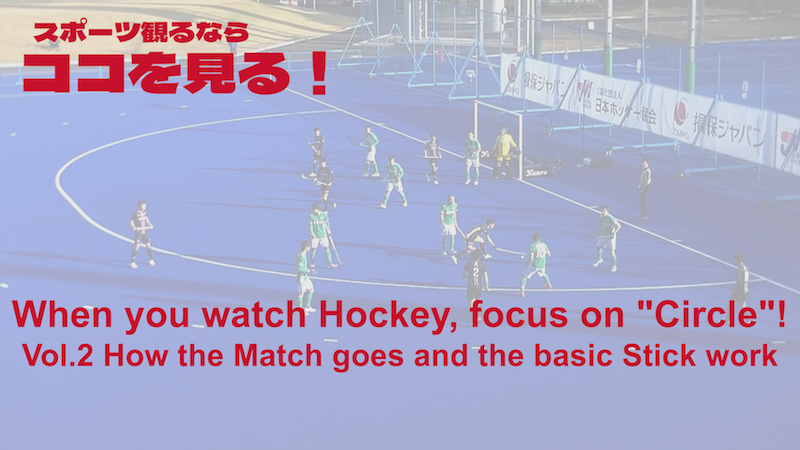
コメントを残す